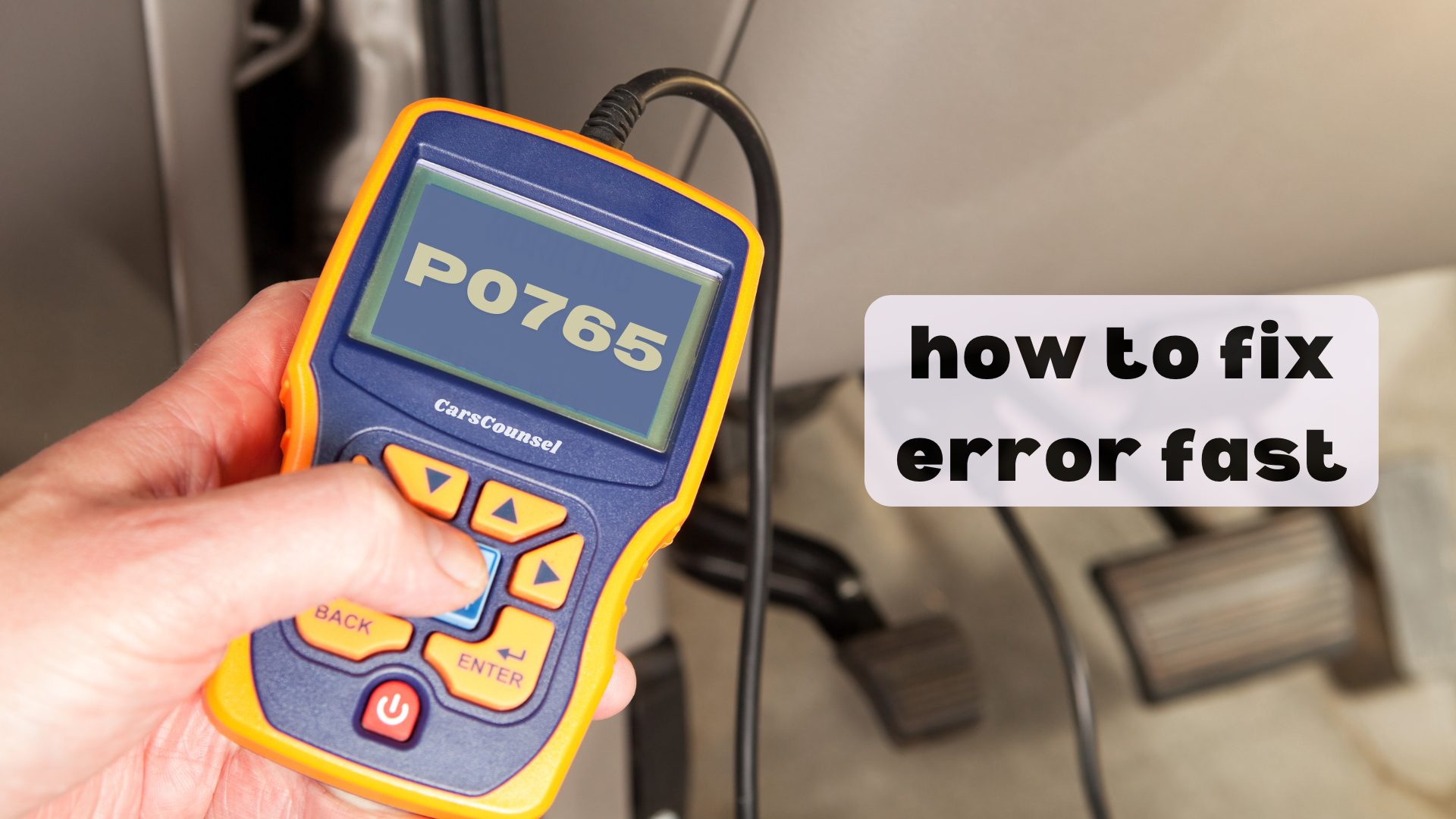Did you know that about 20% of transmission problems come from bad shift solenoids like the one flagged by the P0765 code?
When your car shows this code, it means there’s a problem with shift solenoid ‘D’. This can cause rough shifting or even make your transmission fail if you don’t fix it quickly.
To solve this, start by using an OBD-II scanner to confirm the trouble code. Then, check the transmission fluid and wiring.
Keep reading to find out the exact steps to fix this problem fast and save money on repairs.

Quick Navigation
Key Takeaways
- Check the transmission fluid levels and condition. Refill or replace as needed to ensure the solenoid works properly.
- Use an OBD-II scanner to confirm the P0765 code and find any related errors.
- Inspect and test shift solenoid ‘D’ to make sure it works correctly. Replace it if the resistance values are not within the specified range.
- Look over the wiring and connectors for any damage, corrosion, or continuity problems. Repair or replace them as needed.
Understanding P0765 Code
You’re dealing with a P0765 code, which means there’s an electrical problem with shift solenoid D in your vehicle’s automatic transmission. This issue can cause rough shifting and make it hard to engage fourth gear.
First, understand that shift solenoid D controls the flow of transmission fluid for smooth gear changes. When it malfunctions, the fluid flow gets messed up, causing shifting problems.
To fix this, you need to act fast. Use an OBD-II scanner to confirm the code. Next, check the solenoid for any damage or wear. Test its electrical connections and make sure it’s working properly with a multimeter.
Getting the solenoid to work right is crucial for smooth shifting again.
Common Causes
Several common issues can trigger the P0765 code, and each needs a different approach to fix properly.
First, a worn-out or dirty shift solenoid valve can mess up shifting.
Next, check the wiring and connections for damage or rust; moisture can mess up the electrical parts.
Low transmission fluid can also cause the solenoid to malfunction, making shifts less smooth.
A bad Transmission Control Module (TCM) might send wrong signals, messing up normal operations.
Lastly, things like debris can interfere with how the solenoid works.
Address each potential issue step-by-step to ensure a thorough and effective fix.
Faulty Shift Solenoid
To check if a shift solenoid is faulty, start by unplugging the transmission’s electrical connector and looking at the solenoid for any signs of damage or dirt. A bad solenoid can cause performance problems and needs to be fixed right away.
Here’s what to do:
- Test the Solenoid: Use a multimeter to see if the resistance values are correct.
- Check for Dirt: Look for any debris or fluid on the solenoid.
- Check Fluid Levels: Make sure the transmission fluid level is right to avoid incorrect readings.
- Replace if Necessary: If the solenoid doesn’t pass the tests, replace it to get your transmission working properly again.
Fixing a faulty solenoid quickly will help keep your vehicle running well and stop further transmission damage.
Wiring and Connections
Once you’ve confirmed that the shift solenoid is working, take a look at the wiring and connections to check for any damage or corrosion.
Start by disconnecting the battery to avoid any electrical shocks.
Look at the wiring harness for any frayed wires or worn-out insulation that could mess with the wiring. Use a multimeter to check for continuity problems.
Also, inspect connectors for any signs of rust or corrosion that could block electrical flow. Clean any corroded terminals with contact cleaner and a brush.
If you find damaged connectors, replace them right away.
Put everything back together and reconnect the battery.
Do a final continuity test to make sure everything’s working fine.
Fixing these issues will ensure reliable operation and keep that P0765 code from coming back.
Low Fluid Levels
Check your transmission fluid level by finding the dipstick, pulling it out, wiping it clean, putting it back in, and then pulling it out again to see the fluid level against the marked lines.
Keeping an eye on the fluid is important for your transmission’s health, especially to avoid problems like the P0765 code.
Here’s what to do:
- Make sure the engine is warm: This gives an accurate fluid reading.
- Park on a flat surface: This ensures the reading isn’t skewed.
- Look at the fluid color: It should be clear red; if it’s dark or burnt, it needs changing.
- Refill if needed: Use the transmission fluid recommended by the manufacturer.
Keeping the fluid at the right level ensures your transmission works well and helps prevent solenoid issues that can cause error codes.
Regular checks and timely refills will keep your transmission in top shape.
Transmission Control Module
If your transmission fluid levels are good and the P0765 code is still showing up, the next thing to check is the Transmission Control Module (TCM).
First, find the TCM, which is usually near the transmission housing or under the dashboard. Use an OBD2 scanner to look for any specific error codes related to the TCM. Before you start working on it, disconnect the battery to avoid any electrical issues.
Check the TCM for any signs of damage or corrosion. If it looks damaged, you’ll need to replace it. To do this, disconnect the wiring harness and remove the mounting screws holding the old TCM in place.
Install the new TCM, making sure all connections are secure. Reconnect the battery, clear any error codes with the OBD2 scanner, and take the car for a test drive to make sure the problem is fixed.
Environmental Impact
Environmental factors like dirt and water can really mess up the performance of shift solenoid D, causing the P0765 code. To deal with this, you can take steps that are good for the environment and ensure long-lasting repairs.
Here’s how:
- Regular Cleanings: Keep the area around the transmission clean to stop dirt from building up.
- Waterproofing: Use waterproof connectors to protect against water getting in.
- Eco-friendly Fluids: Choose biodegradable transmission fluids to lessen environmental harm.
- Routine Inspections: Regularly check the solenoid and nearby parts for any signs of wear or damage.
By following these steps, you can keep your vehicle running well and avoid the P0765 code.
Focus on sustainable repairs to make your transmission last longer and be kinder to the environment.
Visual Inspection
Start by looking at the transmission system for any obvious signs of damage like loose wires, rusty connectors, or fluid leaks. These signs can help you know where to focus your inspection.
First, check the wiring harnesses for wear or disconnected wires. Rusty connectors can block electrical signals, so clean or replace them if needed.
Look for fluid leaks around the transmission housing and under the vehicle. Leaks can mean low fluid levels, which can affect how well the solenoids work.
Check the transmission fluid itself; it should be clean and at the right level. A detailed visual inspection can help you find potential problems early, making the repair process easier.
Write down any issues you see before moving on to more advanced checks.
Diagnostic Tools
One essential tool for diagnosing the P0765 code is an OBD2 scanner, which helps you read and understand error codes.
To use this tool effectively, follow these steps:
- Connect the OBD2 scanner: Find the OBD2 port under the dashboard and plug in your scanner.
- Retrieve the error codes: Turn the ignition to the ‘ON’ position without starting the engine. Follow the scanner’s instructions to read the error codes.
- Analyze the codes: Check for the P0765 code and note any other codes that might affect your diagnosis.
- Clear the codes: After making repairs, use the scanner to clear the codes and take the car for a test drive to make sure the issue is fixed.
Repair Solutions
To fix the P0765 code, start by replacing the faulty shift solenoid valve D if it doesn’t pass the multimeter test.
Then, check for any damaged wires or connections and repair them. Corrosion or moisture can mess with the signals.
Make sure the transmission fluid level is good; if it’s low, you might need to flush and refill it.
If the Transmission Control Module (TCM) is bad, replace it to ensure proper signal transmission.
Address these issues quickly to avoid higher repair costs.
Regular maintenance, like checking fluid levels and inspecting electrical components, can help prevent future problems.
Following these steps ensures your transmission runs smoothly and reduces the chances of seeing the P0765 code again.
More OBD-II Codes
Frequently Asked Questions
Can Driving With the P0765 Code Damage Other Transmission Components?
Yes, driving with the P0765 code can harm your transmission and wear out its parts faster. You might notice rough shifting and slipping, which could lead to more costly repairs. It’s important to find and fix the problem as soon as possible.
How Long Does It Typically Take to Fix a P0765 Code Issue?
Fixing it can be like solving a puzzle; it usually takes between 2 to 5 hours. The process involves scanning the car’s computer, looking at solenoid D, checking the wiring, and maybe replacing some parts.
Are There Any Symptoms Before the P0765 Code Triggers the Check Engine Light?
Before the check engine light comes on, you might notice problems with your transmission, such as rough shifting, slipping gears, or delays when you try to change gears. These signs suggest there could be an issue with shift solenoid D, and you should get it checked out and fixed right away.
Can a DIY Approach Effectively Resolve the P0765 Code Problem?
Yes, you can fix the P0765 code problem yourself. Start by using an OBD2 scanner to check the code. Then, look at the wiring, test shift solenoid D with a multimeter, check the transmission fluid levels, and replace any faulty parts if needed.
What Preventive Measures Can Avoid the P0765 Code in the Future?
To prevent future problems, think of it like keeping your car’s transmission protected. Regularly maintain your transmission, check the fluid levels, inspect the wiring, and watch out for debris. These simple steps will help your transmission run smoothly and avoid the P0765 code.
Conclusion
To quickly fix the P0765 code, start by using an OBD-II scanner to confirm the error.
Check and refill the transmission fluid if needed.
Use a multimeter to test shift solenoid ‘D’ and replace it if it’s not working.
Look over the wiring and connectors for any damage to make sure electricity is flowing correctly.
Clear the codes using the scanner and take the car for a test drive to ensure the issue is resolved.
By following these steps—scan, inspect, test, repair, and clear—you’ll effectively fix the P0765 error.

